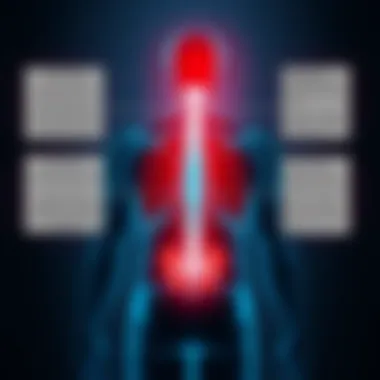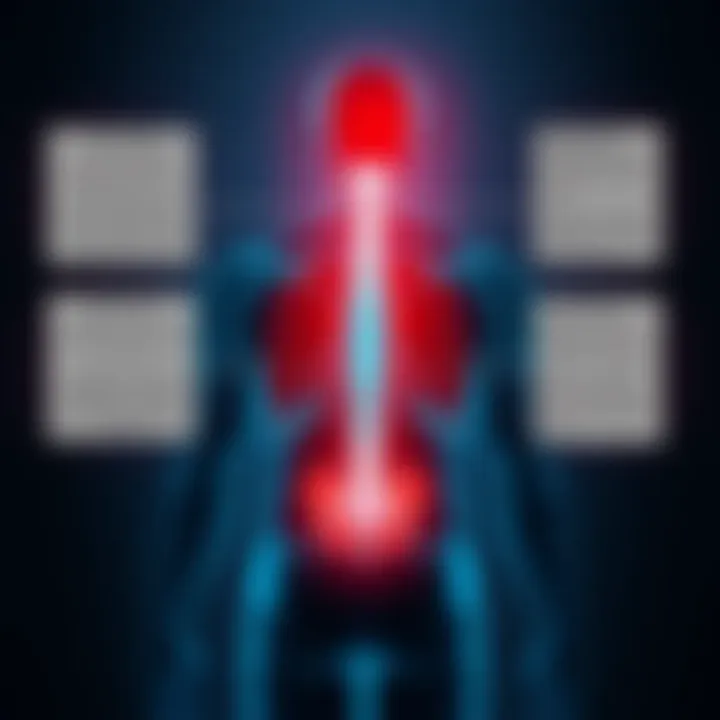The Link Between Stress and Back Pain: Insights


Intro
Stress and back pain might seem unrelated at first glance, yet a significant number of individuals grappling with back discomfort often carry the weight of stress on their shoulders—quite literally. Understanding this connection is essential for anyone looking to alleviate their physical woes while nurturing their mental health. Studies suggest that stress doesn't just affect our mood but can also influence our body's physical response, particularly in the musculoskeletal system.
In this piece, we delve into how these two aspects intertwine and impact overall health, providing insights into wellness strategies that shed light on managing stress to reduce back pain. From understanding mental health intricacies to practical coping techniques, we aim to furnish you with the knowledge necessary to take control of your overall well-being.
Understanding Mental Health and Well-being
Understanding mental health is the stepping stone to recognizing the complexities of the stress-pain relationship. Mental health refers to our emotional, psychological, and social well-being, affecting how we think, feel, and act. It also shapes how we handle stress, relate to others, and make choices.
What is Mental Health?
It encompasses various aspects, including self-esteem, emotional regulation, and resilience. Mental health can be seen as the backbone supporting mental toughness, which is essential when facing life’s many stressors.
The Importance of Prioritizing Mental Well-being
The importance of prioritizing mental well-being cannot be overstated. When people overlook their mental health, they may find themselves entrapped in a vicious cycle—stress exacerbating physical conditions, while physical pain can further deteriorate mental health. Taking action to prioritize mental wellness can foster a healthier relationship with oneself and lead to improved overall health outcomes.
Common Mental Health Challenges and Disorders
Many individuals encounter mental health challenges such as anxiety disorders, depression, and stress-related conditions. Each can impact your body in various ways, and the physical symptoms manifest can often be troublesome. Stress, for example, can manifest as muscle tension, often resulting in back pain. The psychological burden translates into physical discomfort, creating a feedback loop that complicates recovery.
Strategies for Improving Mental Health
Arming oneself with effective strategies for improving mental health can lead to significant changes—not only relieving stress but also mitigating its physical repercussions. Here are a few approaches worth considering:
Self-care Techniques and Practices
- Mindfulness exercises that help focus on the present moment, reducing overwhelming thoughts.
- Journaling can serve as a helpful outlet for processing emotions and stressors.
Building Resilience and Stress Management
Develop life skills that build resilience. This might include maintaining a positive outlook, practicing gratitude, and developing problem-solving skills to navigate life's challenges.
Seeking Professional Help: Therapy and Counseling
For those struggling with persistent stress or pain, reaching out for professional help can be a game-changer. Therapists and counselors can offer support and techniques to cope with psychological hurdles.
Finding Balance in Life
To bridge the gap between mental well-being and physical health, finding balance is crucial. A holistic approach often involves integrating several lifestyle changes into daily life.
Healthy Lifestyle Choices: Diet, Exercise, and Sleep
Essential habits like consuming a well-balanced diet, engaging in regular exercise, and ensuring sufficient sleep form the foundation of both mental and physical wellness. Nutrient-rich foods, such as leafy greens and antioxidants, can help reduce inflammation and improve mood.
Mindfulness and Meditation Practices
Meditation can particularly assist in managing stress while promoting relaxation. Engaging in daily practices, even for just a few minutes, can yield long-lasting benefits and contribute to overall wellness.
Setting Boundaries and Managing Time Effectively
It's vital to learn to say no. By setting boundaries and managing time effectively, you can control your environment, empowering yourself to reduce unnecessary stresses.
Enhancing Personal Development
Personal growth is intricately linked with mental health and well-being. By developing oneself, one can improve how they handle stress and its physical manifestations.
Goal Setting and Productivity Tips
Setting realistic, clear goals can foster a sense of achievement and control over your life. This, in turn, reduces stress levels. Prioritize small, reachable objectives to avoid feeling overwhelmed.
Building Healthy Relationships and Social Connections
Interacting positively with others helps create a supportive network. Whether friends, family, or support groups, human connections can provide comfort and alleviate stress.
Practicing Gratitude and Positivity
Incorporating gratitude exercises into your daily routine can shift focus from stress to appreciation, promoting a healthier mind. This can be simple as jotting down things you're grateful for each day.
Tips for Maintaining Mental Well-being
To prevent burnout and manage life's ups and downs, implementing strategies for maintaining mental well-being is essential.


Strategies for Preventing Burnout
Recognizing the signs of burnout early, such as fatigue or disengagement from work or social activities, allows for timely intervention. Moderate pace, regular breaks, and maintaining a healthy work-life balance can help.
Coping with Challenges and Setbacks
When life throws challenges your way, it's vital to have coping mechanisms ready. Techniques like breath work, distanced perspective, and reframing negative thoughts can help mitigate stress responses.
Creating a Supportive Environment
Cultivating an environment that promotes well-being is crucial. Surround yourself with positive influences, declutter your spaces, and ensure your surroundings reflect tranquility and peace.
Mental well-being is a journey, not a destination. Taking the time to nurture both your mind and body will lead to a healthier, happier you.
Ultimately, fostering a deep understanding of the relationship between stress and back pain warrants immediate attention. By recognizing their interdependency and addressing mental health proactively, individuals may find greater relief and improved quality of life.
For additional resources, consider visiting Mental Health America or National Institute of Mental Health for information and support on mental health and well-being.
Understanding the Connection between Stress and Back Pain
Understanding the relationship between stress and back pain is paramount in today’s fast-paced world. Every day, individuals wrestle with the pressures of work, family responsibilities, and life’s unpredictability. This ongoing tension often doesn’t just settle in the mind but makes its presence felt physically, particularly in the back. By recognizing how stress culminates in back pain, one can wrestle better with this dual challenge, leading not only to relief from discomfort but also to a clearer mind.
Defining Stress and Its Impact on the Body
Stress can be defined as a state of mental or emotional strain resulting from demanding circumstances. At its core, it manifests through various physical responses. When faced with a stressor, the body reacts, often triggering what is known as the "fight or flight" response — a series of physiological changes mediated primarily by the release of hormones such as adrenaline and cortisol. These hormones prepare the body for immediate action but can have lasting effects when stress becomes chronic.
Chronic stress can lead to numerous health issues. Muscles, particularly those in the shoulders and back, tend to tighten as a direct response. Over time, this tension can morph into significant discomfort or pain, setting the stage for acute exacerbations of existing back pain or even the onset of new symptoms. Thus, defining stress comprehensively opens the door to understanding its profound implications on physical well-being.
How Stress Affects Pain Perception
The interplay between stress and pain perception is complex, often blurring the edges between physical and psychological experiences. Stress doesn’t just cause pain; it alters how pain is perceived. Under stress, the body tends to amplify pain signals, rendering normal sensations intolerable. This phenomenon can be attributed to a combination of heightened nerve sensitivity and altered brain chemistry.
Research indicates that when individuals are under stress, their threshold for pain decreases. This means that whereas one might normally assess mild discomfort as just that, under stress, it might feel unbearable. Moreover, stress can lead to heightened focus on pain, causing individuals to ruminate on what they’re feeling, potentially intensifying the experience. In essence, pain becomes a lens through which stress is filtered, creating a cycle that can feel unbreakable.
"Pain is an unavoidable reality for many, yet how we perceive it can shift dramatically based on emotional state and mental health."
Consequently, understanding stress’s influence on both the experience of back pain and the strategies for addressing it becomes essential. Awareness of these connections can pave the way for developing effective coping mechanisms tailored to mitigate the compounded effects of stress and pain.
Physiological Mechanisms Linking Stress and Back Pain
Understanding the physiological mechanisms that connect stress and back pain is a pivotal aspect in unraveling this complex relationship. Stress, despite often being seen through a psychological lens, manifests significantly on the physical front. From the way our muscles react to stress hormones, to how nerve sensitivity might heighten one’s perception of pain, these elements intertwine to create a fabric of discomfort that goes beyond mere mental strain. By addressing these mechanisms, we can not only uncover the roots of back pain but also bridge the gap between physical symptoms and their psychological counterparts.
The Role of Cortisol and Stress Hormones
Cortisol, commonly referred to as the stress hormone, plays a crucial role in the body’s response to stress. When an individual encounters stressors, whether psychological or environmental, cortisol is released from the adrenal glands. Elevated cortisol levels can have far-reaching consequences, especially concerning inflammation and pain perception.
In a stressed state, the body often experiences heightened levels of inflammation. Chronic inflammation can lead to irritation of the spinal nerves, resulting in a feeling of tightness or pain in the back. Furthermore, prolonged exposure to elevated cortisol can cause muscle weakening, as it interferes with protein synthesis, leaving the muscular support system of the spine less robust. This weakened state can directly correlate to increased episodes of back pain in individuals dealing with ongoing stress.
Muscle Tension and Stress Responses
Muscle tension is one of the body’s immediate reactions to stress; think of it as an involuntary reflex. When faced with a threat, the muscles tighten and brace for action—this is often referred to as the fight-or-flight response. However, when stress becomes a constant part of life, this muscle tension can become chronic, leading to severe discomfort.
Muscles in the neck, shoulders, and lower back are particularly vulnerable during such times. A person might not even realize it, but carrying tension in these areas frequently contributes to the development of back pain. Over time, such sustained muscle tension can cause muscular imbalances and strains, further complicating the situation. Active stretching, a few minutes of deep breathing, or even changing posture can serve as simple yet effective remedies to relieve this muscle tightness and help mitigate pain.
Nerve Sensitivity and Pain Amplification
Another critical consideration within the stress-pain nexus is nerve sensitivity. Stress can amplify the pain signals that the nervous system sends to the brain, a phenomenon known as central sensitization. Essentially, when stress hormones flood the body, they can inadvertently heighten the sensitivity of the nerve pathways. This means that even minor pressure on the back or slight tensions can result in increasingly intense sensations of pain.
"When the body becomes overly reactive, situations that typically would be brushed off can result in debilitating discomfort, leading individuals to associate normal daily activities with pain."
Furthermore, individuals experiencing stress tend to have a lower pain threshold, meaning that their perception of what constitutes painful stimuli changes. This interplay can trap individuals in a cycle of pain, where stress exacerbates back pain and vice versa, making it all the more important to recognize and address these underlying physiological responses.
Although understanding these mechanisms can feel like peering into a labyrinth, knowledge is power. Recognizing how cortisol, muscle tension, and nerve sensitivity engage one another can provide a valuable framework for those seeking not just symptom relief, but a more holistic approach to managing stress and its debilitating effects on back pain.
Psychological Factors Contributing to Back Pain
Understanding the psychological elements that contribute to back pain is paramount. Stress, anxiety, and depression are not just ephemeral feelings but can have tangible effects on physical health. When one grapples with chronic pain, it’s crucial to recognize how the mind and body interact.
Various psychological factors can exacerbate or even trigger back pain, highlighting the need for a multifaceted approach to treatment. The mind does indeed affect the body. Individuals may experience an intensification of physical discomfort as anxiety levels rise or when depressive symptoms surface. This section dives into these relationships, illustrating how psychological health can shape the experience of back pain.
Anxiety and Its Physical Manifestations
Anxiety has a sneaky way of showing itself. It might start as a light nagging worry; before you know it, it can escalate into palpable physical symptoms. Muscle tension is one of the most common manifestations of anxiety. Imagine sitting tight at your desk, your shoulders hunched – that tightness can translate directly to back pain, making it a real physical concern.
Moreover, anxiety’s impact is physiological. Elevated cortisol levels can lead to increased inflammation in the body, which can aggravate pain. Many people may not realize that the fight-or-flight response, triggered by anxiety, can cause muscles to contract and shorten. This tension can linger long after the stressful event has faded, causing discomfort that seems unshakeable.


"Emotional stress manifests physically, and back pain can be a chronic reminder of unresolved tension."
Additionally, anxiety can lead to behavioral changes – such as reduced physical activity, which is another way it influences back pain. When people feel anxious, they might avoid movement or exercise that would otherwise bolster muscle strength and support spinal health. This avoidance can create a vicious cycle, where anxiety leads to physical pain and vice versa.
Depression and Chronic Pain Syndromes
Depression often plays a dual role in the experience of back pain. Not only can it make the perception of pain worse, but it can also induce physical changes in the body that contribute to the pain itself.
When someone is grappling with persistent sadness or a sense of hopelessness, their overall energy levels can drop. It’s common for those who are depressed to neglect physical activity, leading to stiffness and weakness in the back muscles. Over time, this can result in chronic pain syndromes, which may be difficult to treat effectively if only physical ailments are considered.
Research suggests that individuals with depression often report heightened sensitivity to pain and may perceive their discomfort as more severe than those without depression. This amplification of pain can make even minor strains feel debilitating, affecting not only physical capabilities but also daily life. Modalities that integrate mental health support, like cognitive behavioral therapy, can be pivotal in breaking this cycle.
Coping Mechanisms and Their Effectiveness
When faced with pain, developing effective coping mechanisms can make a world of difference. A variety of approaches exist, but not all are created equal. It's fundamental to find what resonates personally. Here are a few methods that have shown promise:
- Mindfulness and Meditation: These practices encourage grounding in the present moment and help to alleviate the grip of stress and anxiety.
- Cognitive Behavioral Therapy (CBT): This therapeutic approach works by altering negative thought patterns and can help individuals reframe their perceptions of pain.
- Support Groups: Engaging with others who understand the struggle can diminish feelings of isolation and provide insights into personal challenges.
It’s essential to remember that while coping mechanisms can alleviate stress and, by extension, back pain, they often work best when individualized. There’s no one-size-fits-all solution. Consulting with a mental health professional can provide tailored strategies that address both psychological and physical stressors.
In summary, recognizing and addressing the psychological factors contributing to back pain isn’t just about treating symptoms; it’s about paving the way to lasting relief. Emphasizing mental health and its interplay with physical pain can lead to a more comprehensive approach to managing back pain.
Identifying Symptoms of Stress-Induced Back Pain
Understanding how stress can contribute to back pain is essential for timely intervention and management. When individuals experience stress, it can lead to a cascade of physiological and psychological changes. Recognizing the symptoms of stress-induced back pain is critical for several reasons. First, it helps people discern between pain that stems from psychological stress versus pain resulting from physical injuries or other medical conditions. This differentiation can lead to appropriate treatment, allowing an individual not just to alleviate pain but also to address the underlying stress more effectively.
Moreover, identifying these symptoms empowers individuals to take charge of their health. Knowing that anxiety or workplace pressure could manifest as discomfort in the back fosters a proactive approach. People can then incorporate stress management techniques into their daily routines, which may reduce the intensity and frequency of symptoms over time.
Common Symptoms to Recognize
When discussing stress-induced back pain, several symptoms frequently surface. Keep an eye out for:
- Muscle Tension: Often, when individuals are stressed, they unconsciously tighten their muscles. This muscle tension, particularly in the shoulders and lower back, can lead to discomfort or aching sensations.
- Localized Pain: Unlike the dull, sharp pain of an injury, stress-related pain can feel more like a persistent tension or pressure, especially in the lower back region.
- Fatigue: Stress can drain energy levels, leading to an overall sense of fatigue. This feeling can also make any existing back pain feel worse.
- Changes in Sleep Patterns: Since stress can disrupt sleep, those suffering might notice increased stiffness or soreness upon waking, attributed to poor recovery during sleep.
Recognizing these symptoms can be the first step towards alleviating pain and promoting overall wellness.
Differentiating Stress-Related Pain from Other Types
Understanding what type of pain one is experiencing is key for effective management. Stress-related back pain often presents differently from physical injury pain or chronic conditions like arthritis. Here are some pointers to help differentiate:
- Onset: Stress-induced back pain generally correlates with heightened stress levels. If you notice your back pain intensifies during particularly stressful times, there's a correlation worth noting.
- Pain Quality: Pain from stress might feel more like a constant pressure or a soft ache rather than a sharp or stabbing sensation typically associated with injury.
- Location: Stress-related pain often affects specific muscles or areas of the back, particularly in the upper or lower regions rather than being widespread.
- Physical Responses: Accompanying symptoms such as anxiety or restlessness may also provide clues. For example, if back pain comes hand in hand with feelings of worry or nervousness, it's more likely to be stress-related.
By being aware of these distinctions, individuals can not only better navigate their pain but can also make informed decisions regarding treatment options.
Remember, understanding the source of discomfort can pave the way for effective relief!
For more information on back pain management, visit these resources:
Strategies for Managing Stress to Alleviate Back Pain
In the journey to understand how stress unravels in the body, especially concerning back pain, it's crucial to identify effective managing strategies. A sound plan to combat stress not only leads to sore muscle relief but also improves overall mental wellness. We live in a fast-paced world, and managing the rollercoaster of stress can significantly impact physical health—especially for those already battling back discomfort. By utilizing methods rooted in psychological practice, physical activity, and alternative therapies, individuals develop robust coping mechanisms that alleviate both stress and its corporeal manifestations.
Cognitive Behavioral Approaches
Cognitive Behavioral Therapy, or CBT for short, is a valuable tool that many find beneficial in tackling stress-related back pain. This structured, goal-oriented therapy aims to modify negative thoughts that might contribute to both stress and pain perception. Through exploring thoughts and beliefs around pain, individuals can reshape their mindset.
For instance, if someone perceives pain as a signal of danger, CBT can help reframe that idea to view pain as a mere sensation. This shift can lessen anxiety around pain and potentially reduce its intensity. Notable elements of CBT in this context include:
- Identifying Triggers: Understanding what situations provoke stress and how these correlate to physical symptoms.
- Developing Coping Strategies: Crafting personalized techniques to manage thoughts regarding pain, fostering a constructive mental space.
- Goal Setting: Establishing tangible goals to slowly disengage from detrimental thought patterns.
Mindfulness and Relaxation Techniques
Mindfulnes and relaxation go hand in hand when dealing with stress and back pain. These practices promote relaxation by cultivating present-moment awareness, which can lower muscle tension. By exercising mindfulness, even in minute doses, individuals can observe their stress response and find the space between reaction and action. Key techniques include:
- Meditation: Concentrating on breath can center the mind; even a few minutes a day can ease tension.
- Progressive Muscle Relaxation: This approach involves tightening and releasing muscle groups, promoting a deep sense of softness throughout the body.
- Guided Imagery: Imagining serene places or peaceful scenarios can foster a state of calmness, distracting individuals from pain.
When practiced consistently, these techniques forge pathways to serenity and help release the weight of stress.
The Role of Physical Activity and Exercise
Physical activity serves as a double-edged sword in the context of stress and back pain. While stress can inhibit the inclination to move, staying active is critical for bolstering physical health and mental fortitude. Regular exercise helps release endorphins, which combat pain while boosting mood. To address both stress and back discomfort effectively, consider:
- Low-Impact Exercises: Yoga and pilates strengthen muscles around the spine, aiding in reducing pain while promoting relaxation.
- Aerobic Activities: Walking, swimming, or cycling can reduce stress hormones and enhance physical stamina.
- Routine Consistency: Establishing a regular exercise schedule cultivates discipline and can be a form of stress relief in itself.


Alternative Therapies for Pain Relief
Integrating alternative therapies into one’s lifestyle can facilitate stress management and relieve back pain. These approaches provide options beyond conventional treatments, offering a chance for individuals to explore holistic methods. Popular alternatives include:
- Acupuncture: This ancient practice aims to stimulate specific points in the body, potentially alleviating pain and stress through the release of natural painkillers.
- Massage Therapy: Engaging in regular massage can unwind tight muscles, reduce anxiety, and enhance mobility.
- Chiropractic Care: This is focused on spinal alignment and overall physical well-being, possibly easing both physical pain and stress levels.
The Importance of Seeking Professional Help
Stress and back pain often intertwine in a complex web, affecting not just the physical but also the psychological facets of well-being. When suffering from persistent back pain, it can be tempting to try self-treatments or just tough it out. However, seeking professional help is not only prudent; it can be a necessary step towards understanding and alleviating both stress and pain. The multifaceted nature of these issues means that professional intervention can provide a comprehensive assessment and personalized strategies tailored to individual needs.
The mental strain of dealing with chronic pain can be quite the bear. It’s often the case that what starts as a stress-related discomfort morphs into a chronic condition, leading to a vicious cycle where pain exacerbates stress, which in turn aggravates pain. Professionals can interrupt this cycle by offering insights that self-help methods may miss. They are equipped to recognize red flags in symptoms, ensuring individuals don’t overlook more serious underlying conditions that could be contributing to their discomfort.
Additionally, engaging a healthcare provider opens up a dialogue about relevant medical history, lifestyle factors, and emotional health, which are all crucial in tailoring a treatment plan. Professionals, ranging from physiotherapists to psychologists, can guide patients through evidence-based solutions, setting them on a path to recovery, rather than a maze of trial and error.
When to Consult a Healthcare Professional
Knowing when to take that plunge and consult a healthcare professional can feel controversial. Many individuals wrestle with questions such as: Is this pain normal? Can I resolve this with rest? The best course of action is to seek help when:
- Pain lasts longer than a few weeks: If back pain persists despite home care, it signals a need for professional evaluation.
- You experience accompanying symptoms: Symptoms like numbness, tingling, weakness in legs, or trouble controlling bladder/bowel function may require immediate medical attention.
- Daily activities become compromised: If pain limits your day-to-day activities, then it’s time to speak with a professional.
- Stress or anxiety escalates: When dealing with chronic pain, if stress levels soar to a point where it interferes with your sleep or work, it's vital to consult someone who can guide you through these feelings.
In these situations, it’s wise to consult a healthcare professional who can begin identifying underlying issues and exploring effective interventions.
Overview of Treatment Options
Once a healthcare professional is involved, a vast landscape of treatment options opens up. Here’s an overview of approaches that can be effectively employed:
- Physical Therapy: Tailored exercises and stretches can strengthen muscles and improve posture. A physical therapist specializes in guiding patients through rehabilitation while addressing stresses that contribute to pain.
- Cognitive Behavioral Therapy (CBT): This form of therapy can help reshape negative thought patterns related to pain and stress, providing coping strategies that help manage pain perception.
- Medication Management: Healthcare providers may recommend anti-inflammatory drugs or muscle relaxants for immediate relief, which can be a timely component in a comprehensive treatment plan.
- Mindfulness Techniques: Incorporating practices like yoga or meditation can reduce stress and enhance physical well-being, offering both mental clarity and pain relief.
- Alternative Therapies: Acupuncture, massage therapy, or chiropractic care might also be included based on individual preferences and responses.
Combining these treatments can lead to a more holistic approach, addressing both the psychological and physiological aspects of back pain.
In modern wellness discussions, it's increasingly recognized that the road to physical comfort often begins with understanding one's mental and emotional landscape. Finding the right professional support can be the game-changer on this journey toward a stress-free existence, with minimal back pain.
"Pain is inevitable, but suffering is optional."
For anyone grappling with stress and back pain, acknowledging the importance of professional help could be the first big step toward better health.
Long-Term Implications and Preventive Measures
Understanding the long-term implications of stress and its connection to back pain is critical, as it allows individuals to better manage their health. The relationship between stress and physical health isn't just a fleeting issue; it has cascading effects that can persist over time. Those who experience chronic stress often find themselves grappling with persistent back pain, which can interfere with daily living and overall quality of life. Therefore, recognizing these connections early on is crucial, as it can facilitate timely intervention and preventive measures that spare individuals from prolonged discomfort and suffering.
The long-term effects of chronic back pain linked to stress are worth noting. Studies suggest that people enduring this dual burden may also face additional risks like depression, anxiety, and a diminished capacity for work or engaging in hobbies. These ramifications extend far beyond mere physical discomfort. They infiltrate every aspect of life, from relationships to professional endeavors, often leading individuals to create a cycle that is difficult to escape.
Understanding Chronic Back Pain Risks
Identifying the risks associated with chronic back pain is a strategic component of addressing their root causes, particularly stress. Long-lasting back pain can lead to a drastic decrease in an individual's physical activity levels. As the muscles weaken and flexibility diminishes due to inactivity, another layer of strain is added, steering a person further down the road of pain and discomfort.
Moreover, without proper management, chronic pain can evolve into a significant psychological burden. Those living with ongoing pain are frequently faced with altered mood states, depression, and anxiety. According to the American Psychological Association, the likelihood of experiencing mental health issues increases significantly among those suffering from chronic physical ailments. While physical treatment is essential, overlooking the psychological aspect can make treatment ineffective.
Awareness and education concerning these risks are essential. By recognizing the potential outcomes of untreated stress and back pain, individuals may be more inclined to seek help before problems develop further. A few key factors to consider include:
- Escalation in pain severity over time.
- Development of co-occurring conditions like anxiety or depression.
- Altered reactions to pain due to prolonged stress responses.
Building Resilience Against Stress
Building resilience is about more than just enduring stress; it is about thriving despite it. Developing coping strategies can significantly mitigate the impact of stress on both mental and physical health. Resilience involves training the mind and body to respond positively to stressors, thereby lowering the overall stress levels.
To promote resilience against stress, consider these strategies:
- Mindfulness practices: Engaging in mindfulness meditation has been shown to diminish anxiety and improve emotional regulation, which can directly alleviate physical symptoms associated with stress.
- Regular exercise: Not only does physical activity strengthen the body, but it also releases endorphins, commonly known as the body’s natural painkillers, which can significantly ease back pain.
- Social support: Creating and maintaining strong relationships with family and friends can provide emotional support, which is vital for managing stress.
- Healthy routines: Developing consistent and effective daily routines fosters predictability and control, which can help in reducing overwhelming feelings associated with stress.
Ultimately, building resilience requires a multifaceted approach. It’s about combining lifestyle changes, seeking help when needed, and fostering a mindset geared towards overcoming challenges. Practicing these methods is not a quick fix but a long-term investment in one’s health and wellness.
"Investment in knowledge always pays the best interest." - Benjamin Franklin.
Recognizing and addressing the implications of stress and back pain is essential for living a balanced life. Each of these strategies contributes not just to relieving immediate symptoms but also to fortifying one’s capacity to deal with stress in the future, making them paramount for those seeking to prioritize their mental health and physical wellness.
Finale: Integrating Insights for Better Management
It’s crucial to realize that addressing the mental side of pain can be just as important as treating the physical symptoms.
Incorporating a holistic approach, which encompasses both physical and mental health, gives individuals an advantage. Acknowledging that back pain often does not exist in a vacuum can empower those affected to seek comprehensive treatment. This includes not only medical advice but also lifestyle adjustments that prioritize mental well-being. Techniques such as cognitive-behavioral therapy or mindfulness practices can create resiliency in the face of stress—reducing its grip on one's life and health.
Additionally, promoting healthy coping mechanisms and prioritizing overall mental health means acknowledging the mind-body connection, which is often overlooked. Physical activity, when approached thoughtfully, also contributes significantly. Regular exercise not only strengthens the muscles around the spine but also elevates mood through the release of endorphins, acting as natural painkillers.
A Holistic Approach to Stress and Pain
Recognizing that the experience of pain is shaped by emotional states is vital in devising an effective management strategy. A holistic approach to stress and pain shifts focus from merely treating symptoms to understanding the underlying connections between mind and body. This encompasses several components:
- Stress Management Therapies: Techniques like meditation and yoga not only help in reducing muscle tension but also in calming the mind.
- Physical Exercise: Engaging in regular physical activity can strengthen the back muscles, promote flexibility, and release pent-up stress.
- Healthy Lifestyle Choices: A diet rich in anti-inflammatory foods, coupled with adequate hydration, supports overall body health, which plays a role in pain management.
- Social Support: Connecting with family and friends can provide emotional relief, thus helping combat stress and its related pain.
- Professional Guidance: Consulting healthcare professionals for a tailored management plan ensures all aspects of both stress and back pain are addressed.
Embracing a holistic view allows one to unveil a richer understanding of connection between emotional health and physical wellness. People are encouraged not just to react to back pain, but rather to construct proactive strategies, combining physical care with nurturing mental health. This comprehensive approach is pivotal for individuals wanting to thrive rather than just survive.















